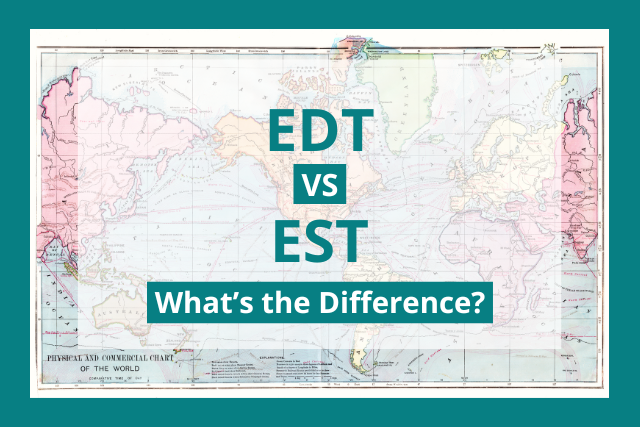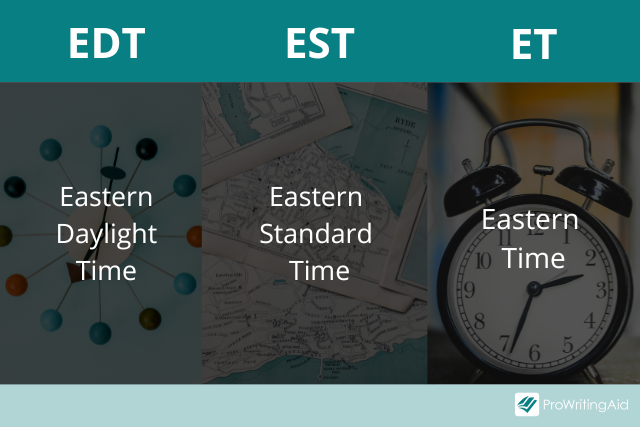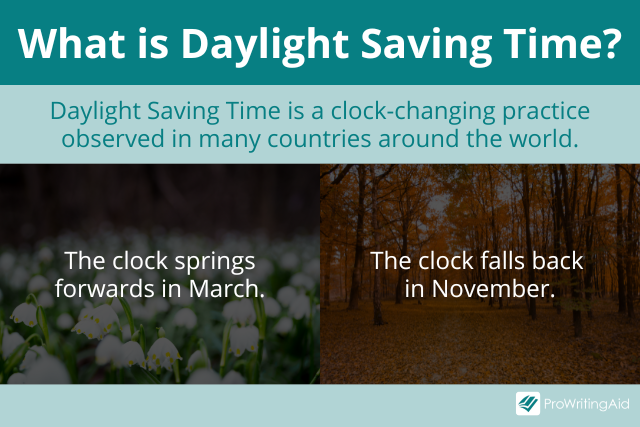
If you know anyone who lives in the Eastern parts of North America, Central America, or the Caribbean, you’ve probably seen the initialisms EDT, EST, and ET before.
All three of these initialisms refer to the Eastern Time Zone, the time zone that spans from eastern Canada down to Panama.
If you’re wondering why there are three different abbreviations for the same time zone, you’re not alone. Many people mix up these three initialisms every day.
So what exactly are the differences between EDT, EST, and ET?
The short answer is that EDT stands for Eastern Daylight Time, EST stands for Eastern Standard Time, and ET stands for Eastern Time.

This article will give you a complete guide to EDT vs EST vs ET and help you use these abbreviations correctly in your written communication.
What’s the Difference Between EDT, EST, and ET?
The reason there are three different initialisms for the same time zone is because of Daylight Saving Time, which is a clock-changing practice observed in many countries around the world.
The purpose of Daylight Saving Time is to ensure that darkness falls later in the winter. On the first Sunday of November, the clock gets set back one hour, and on the second Sunday of March, the clock gets set forward one hour.

As a result, the time zone is called Eastern Daylight Time (EDT) half the year, after the clock is set forward, and Eastern Standard Time (EST) during the remainder of the year, after the clock is set back.
Meanwhile, ET (Eastern Time) is a flexible term that refers to either EDT or EST, whichever one is currently in use.
Let’s take a closer look at each of these acronyms and when it’s appropriate to use them.
What Is EDT?
EDT stands for Eastern Daylight Time. It’s four hours behind the Coordinated Universal Time, the global time standard used to synchronize clocks around the world.
In areas that observe Daylight Saving Time, EDT is the local time zone from the second Sunday in March to the first Sunday in November.
It’s correct to use EDT in spring and summer.
What Is EST?
EST stands for Eastern Standard Time. It’s five hours behind the Coordinated Universal Time (UTC-5).
In areas that observe Daylight Saving Time, EST is the local time zone from the first Sunday in November to the second Sunday in March.
It’s correct to use EST in autumn and winter.
What Is ET?
ET stands for Eastern Time. It’s a catch-all term that refers to EST or EDT, whichever currently applies.
If you’re in an area that observes Daylight Saving Time and you’re not sure whether to use EDT or EST, it’s always safe to use ET. ET refers to EST when EST is the local time and EDT when EDT is the local time.
Which US States Use ET, EST, and EDT?
There are nine standard time zones in the United States. From east to west, they are: Atlantic Standard Time (AST), Eastern Standard Time (EST), Central Standard Time (CST), Mountain Standard Time (MST), Pacific Standard Time (PST), Alaskan Standard Time (AKST), Hawaiian-Aleutian Standard Time (HST), Samoa Standard Time, and Chamorro Standard Time.
The Eastern Time Zone (EST/EDT/ET) includes the following US states:
- Connecticut
- Delaware
- District of Columbia
- Parts of Florida (not Bay, Calhoun, Escambia, Holmes, Jackson, Okaloosa, Santa Rosa, Walton and Washington counties and northern Gulf county, which are in Central Time)
- Georgia
- Parts of Indiana (not some northwestern counties near Chicago and southwestern counties near Evansville, which are in Central Time)
- Parts of Kentucky (not most western counties, which are in Central Time)
- Maine
- Maryland
- Massachusetts
- Parts of Michigan (not Dickinson, Gogebic, Iron, and Menominee, which are in Central Time)
- New Hampshire
- New Jersey
- New York
- North Carolina
- Ohio
- Pennsylvania
- Rhode Island
- South Carolina
- Parts of Tennessee (not most western counties, which are in Central Time)
- Vermont
- Virginia
- West Virginia
Keep in mind that the borders between time zones don’t always correspond to the borders between states, so different people living in the same US state might live in different time zones.
It’s best practice to check the time zone of a specific city or county to make sure you’re using the correct one.
Which Countries Use ET, EST, and EDT?
The Eastern Time Zone encompasses parts of the following countries:
- United States
- Canada
- Bahamas
- Haiti
- Cayman Islands
- Jamaica
- Mexico
Out of all the countries on the list above, these are the ones that observe Daylight Saving Time every year, and therefore use both Eastern Standard Time (EST) and Eastern Daylight Time (EDT):
- United States
- Bahamas
- Haiti
- Mexico (except for Quintana Roo)
- Canada (except for Southampton Island)
Not all countries observe Daylight Saving Time. The following places are the ones that don’t switch their clocks every year, and are therefore in Eastern Standard Time (EST) all year long:
- Cayman Islands
- Jamaica
- Panama
- The Mexican state Quintana Roo
- The Canadian island Southampton Island
How to Know Whether It’s EST or EDT Right Now
Is it EST or EDT right now? This is a common question that many people ask every year.
One way to remember the difference between EST and EDT is to remember that the D in EDT stands for Daylight.
The season with the most daylight is summer, when the sun rises early and sets late. Therefore, EDT is the time zone used in summer and spring, while EST is the time zone used in winter and autumn.
If you’re not sure whether to use EDT or EST, it’s always safe to stick with ET.
Conclusion on EDT vs EST vs ET
It’s important not to mix up EDT and EST, especially in the digital age, so you don’t accidentally schedule a conference call for the wrong time. After all, UTC-4 is a full hour ahead of UTC-5.
Hopefully, this article helps you keep your time zones straight!

